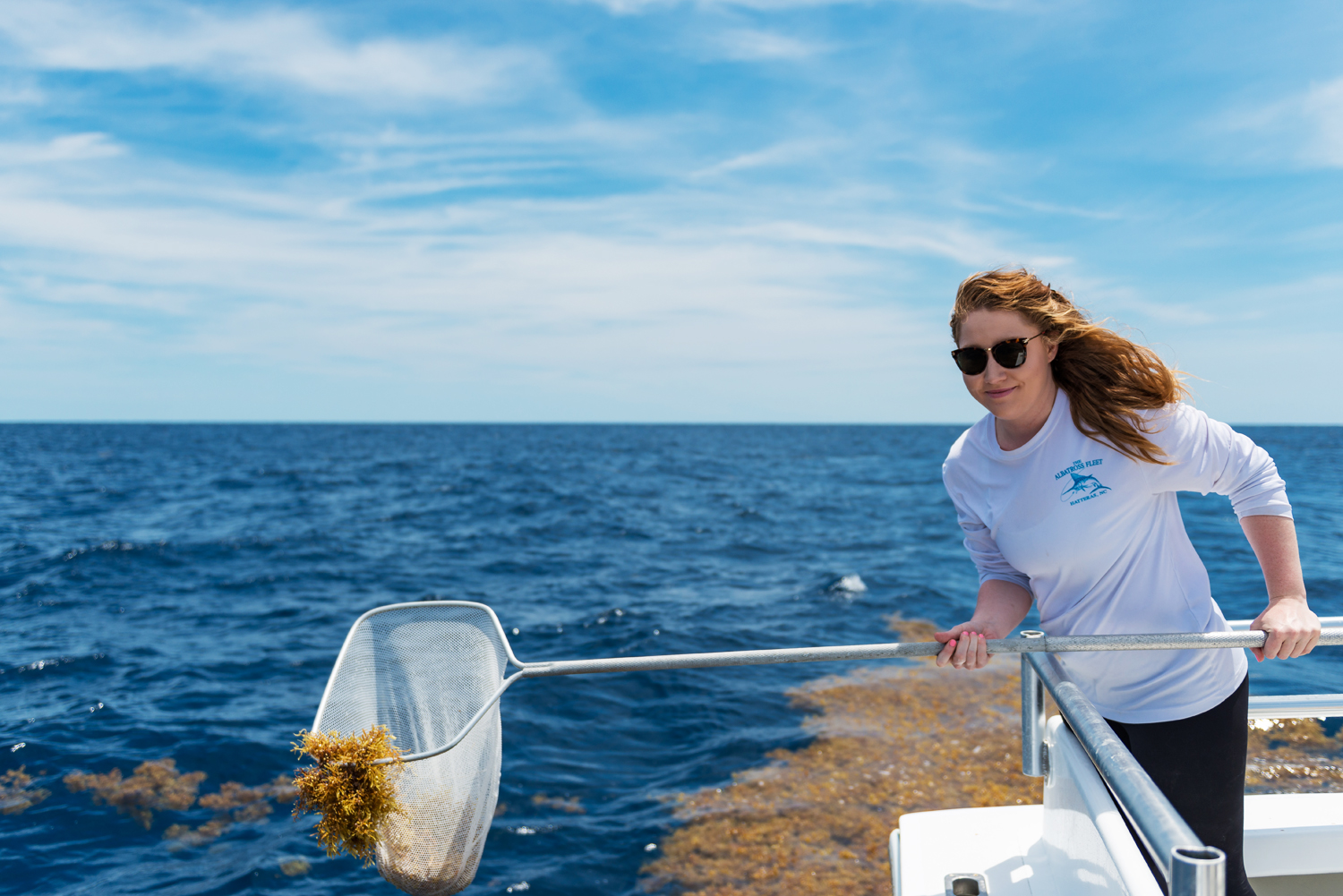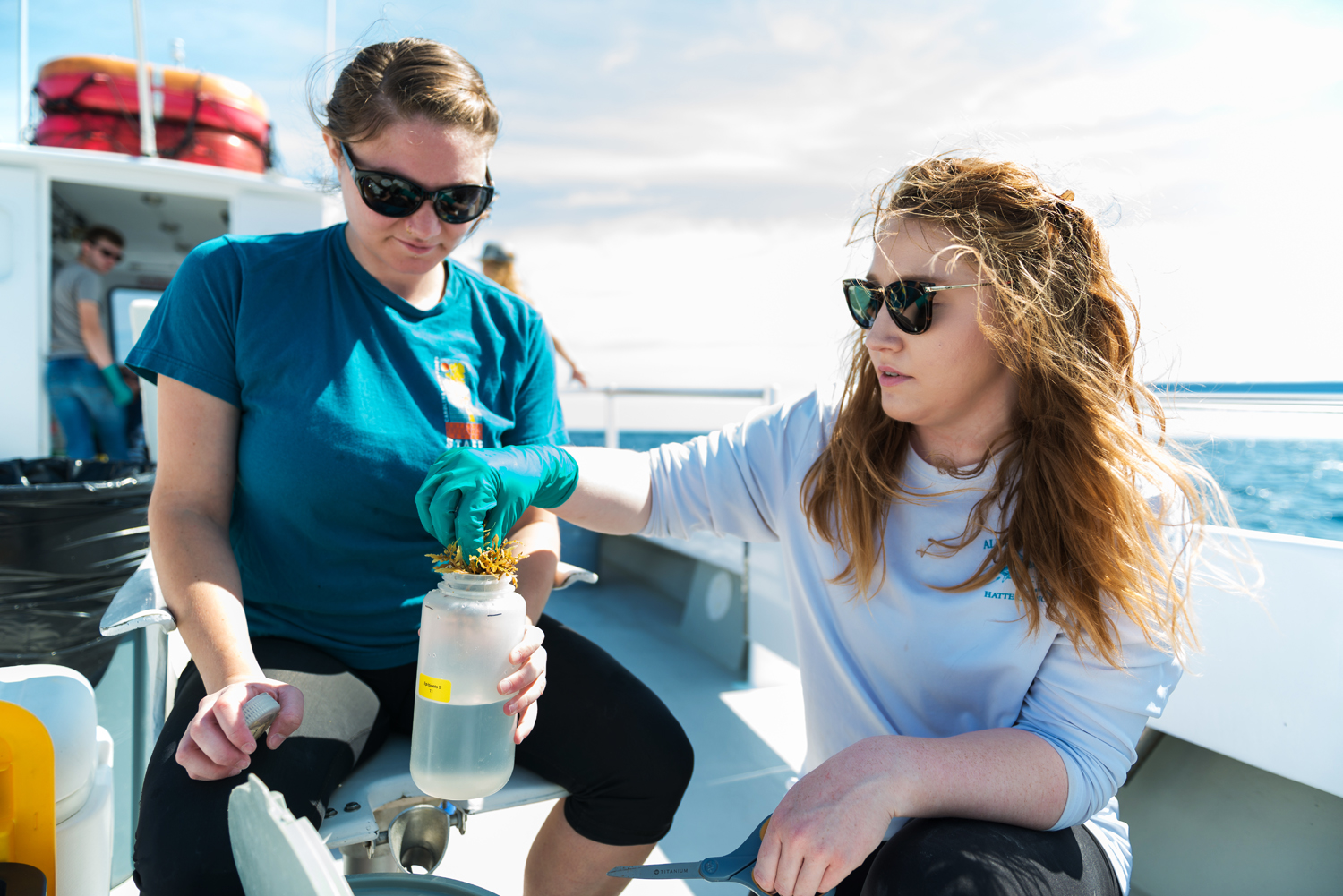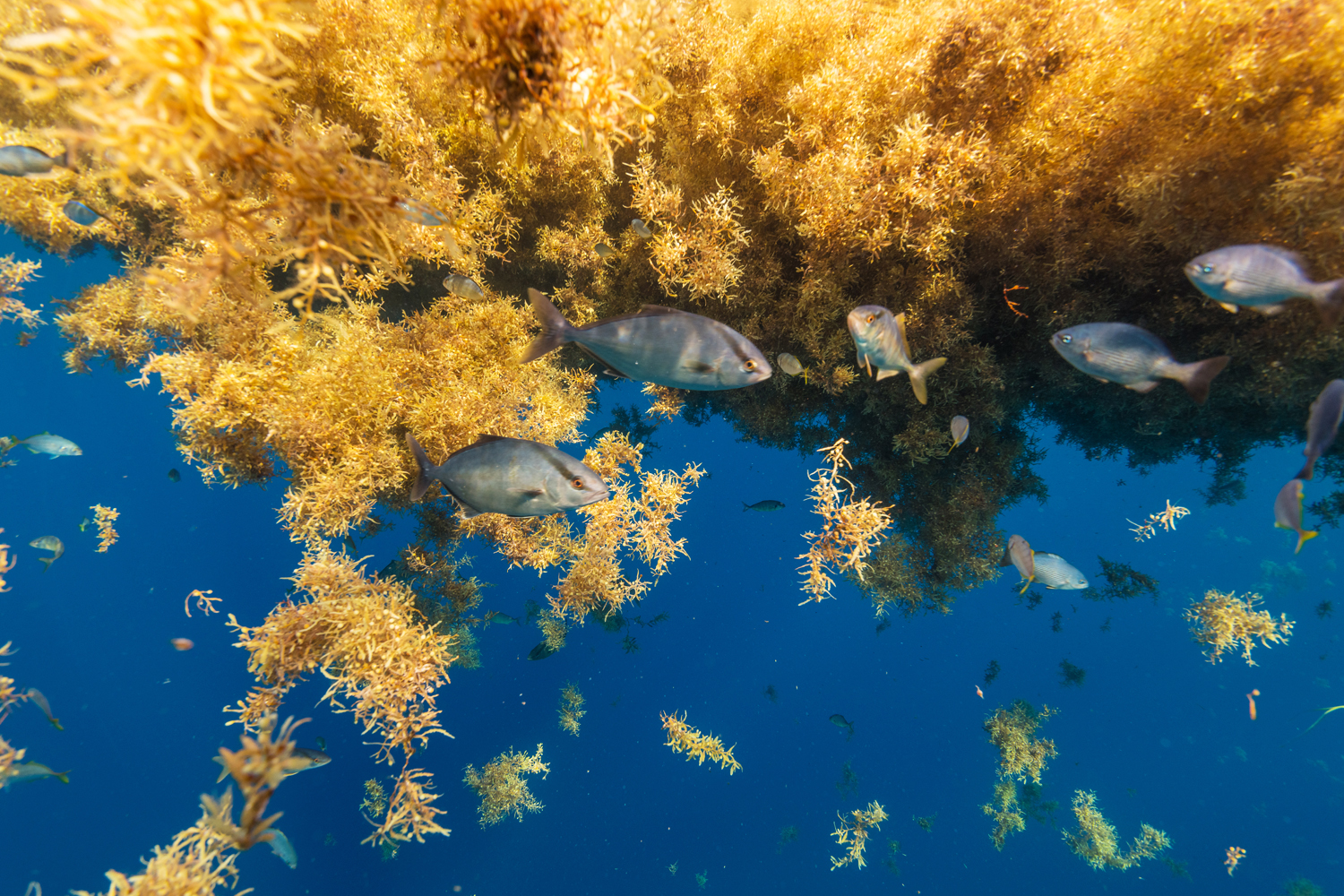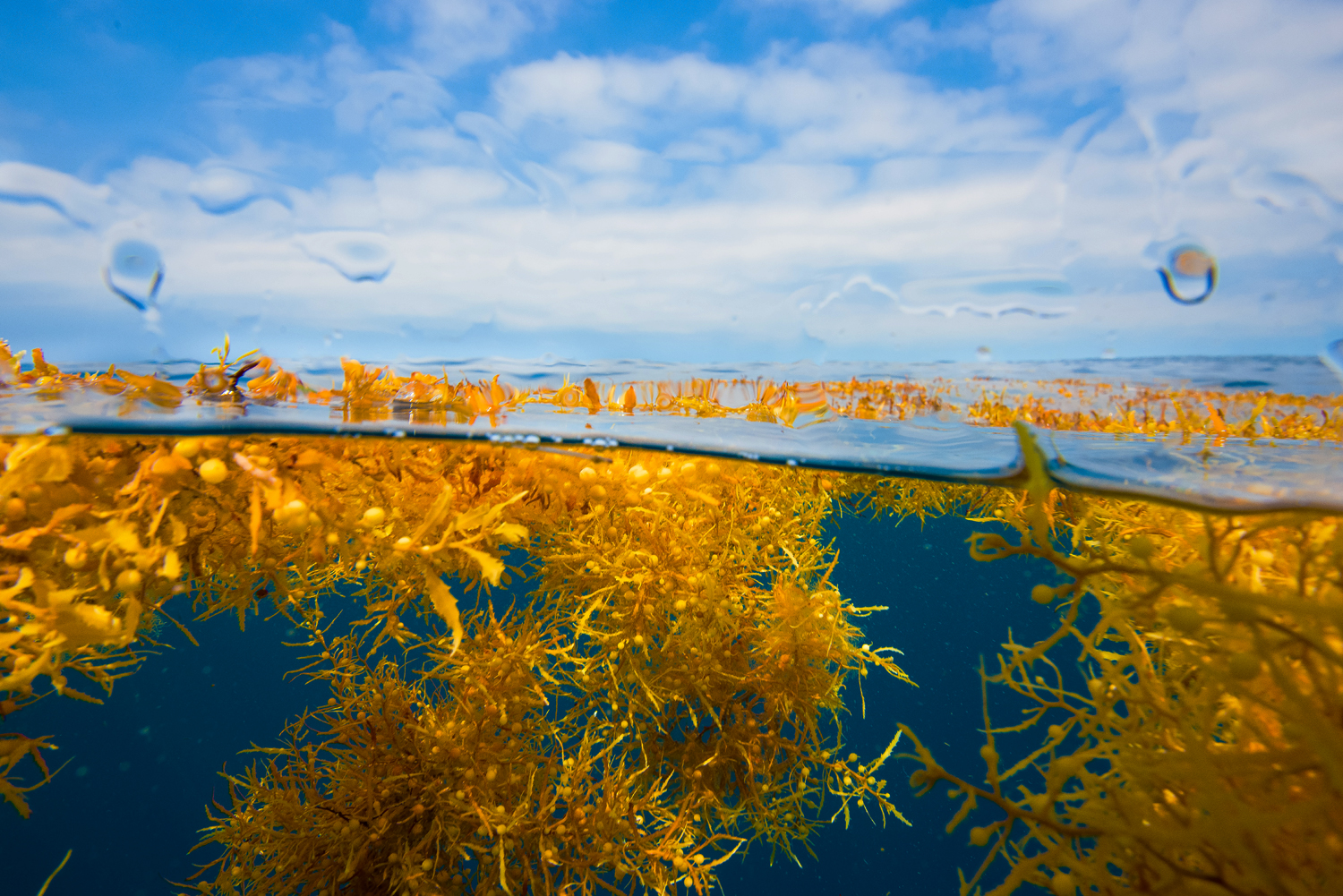A warm, salty breeze blew through my hair as I stood on the deck of the Albatross III, which sat about 40 miles off the coast of Cape Hatteras, North Carolina. I looked down into the deep, clear blue of the Gulf Stream and saw what looked like a dining table flying through the water. It was a leatherback, the largest species of turtle in the world, reaching up to 6 feet in length.
It was September 2016, my first ever offshore research cruise, and we were trolling along the western edge of the Gulf Stream current in search of pelagic sargassum, a brown macroalgae in the seaweed family that spends its entire life cycle floating at the surface of the ocean in large masses known as mats.
My interest in sargassum all started when I accepted a position as a research technician in Lindsay Dubbs’ lab fresh out of college. Her research focus is understanding how hypothetical renewable energy installations in the Gulf Stream may affect protected habitats, namely sargassum, and species.

Carolina PhD student Claire Johnson collects sargassum from the Gulf Stream off the coast of North Carolina. (photo by John McCord)
With the help of Professor Dubbs, now my graduate research advisor, my goal is to investigate the biological cycling of nutrients — specifically nitrogen — by the microbial community living on the surface of sargassum and to understand how specific environmental variables alter this process. To study this, we wait for the Gulf to present perfect conditions: high visibility, low wind, and calm seas. And then, we adventure out into the open ocean to catch the sargassum that floats along its currents.
The Gulf Stream is fast, flowing about two meters per second on average — the same rate as a brisk walking pace. It’s like a river in an ocean, carrying an amount of water that roughly equals 10 times the flow of all the world’s rivers combined. The combination of volume and speed make the Gulf Stream a very attractive source of renewable energy, especially in locations where it comes close to shore.
The current hugs the southeastern coast of Florida, heading further offshore as it moves north. It approaches land near Cape Hatteras, North Carolina, before making a fairly dramatic turn northeast into the Sargasso Sea — an area within the Atlantic Ocean surrounded by currents and characterized by calm waters and masses of sargassum.
Throughout this journey, the Gulf Stream transports sargassum from the Gulf of Mexico to the Sargasso Sea. Pelagic sargassum is unique in the open ocean because it provides structure in an environment otherwise devoid of such complexity. The rich nutrient conditions created by the unique microbial community living within this seaweed contribute to a large food web: It serves as a habitat and foraging site to seabirds, hatchling and juvenile sea turtles, and a diverse assemblage of fish and invertebrates, some of which can only be found within the mats and patches.
Some notes on nitrogen
Nitrogen is an essential element — all living creatures require it. It is a major component of metabolites, amino acids, nucleic acids, and proteins. In the open ocean, more nitrogen means greater biological productivity and growth.
The atmosphere provides the largest source of nitrogen, comprising almost 80% of the air we breathe. In this form, it is biologically unavailable to most lifeforms except for a select few microbes called diazotrophs, which can fix, or transform, nitrogen to ammonia.
Prior to the industrial revolution, biological nitrogen fixation was responsible for nearly 98% of all reactive nitrogen on Earth, and 70% of that came from marine diazotrophs. The evolution of diazotrophs was an incredibly significant event in life’s early history and remains an important process even today.
Now, we know that these marine microbes are incredibly diverse and can be found in virtually all marine habitats from shallow coastal areas to the open ocean and deep sea.

Johnson (right) and research technician Holly Roberts collect sargassum in bottles to bring back to the lab for later analysis. (photo by John McCord)
Few studies have measured nitrogen fixation within the sargassum community, and those that have captured only brief snapshots in time. These processes are best observed long-term. Factors like light, temperature, salinity, oxygen, inorganic nutrients, and microbial community composition and structure are key to accurately estimating the amount of nitrogen fixed by this community. But such data are rare, as scientific research vessels typically chartered for marine research are out at sea for weeks at a time, making it a costly and logistically challenging endeavor.
Thanks to the proximity of the Gulf Stream to our lab on Roanoke Island, our team has taken seasonal trips to collect sargassum for nearly a decade. Our use of chartered fishing vessels allows us to make relatively short but frequent, day-long trips offshore, which has given us an invaluable amount of data.
A typical day offshore
I set my alarm for 4:15 a.m. so that I can get to the lab with just enough time to fill the sample coolers with ice and finish strapping down the dozens of buckets in the truck bed so that we can get to the dock in Hatteras. By 7 a.m. we’re aboard the Albatross III, embarking on an hours-long journey through the choppy waters of Hatteras Inlet. In the spring, you can usually catch an amazing sunrise over the water.
Depending on the position of the Gulf Stream, it can take us anywhere from one to two hours to reach its western edge and, if we’re lucky, we’ll begin to see sargassum.
To understand how sargassum and the community it hosts influences its immediate environment, we compare sites within the Gulf Stream with and without the algae. Much of our cruise time is spent collecting hundreds of liters of water, hauling them up and over the boat in 50-pound buckets for filtration in the lab later in the day.
And of course, then there’s the sargassum. If you ever encountered its green tangles out on the open ocean before, you’ll be absolutely amazed by all the creatures you find living on and amongst it — some you can see and many more that you can’t. Because we are specifically interested in microbially-mediated processes, we carefully sort through each frond we collect.

Sargassum mats support an array of life that includes small fish and brine shrimp. (photo by John McCord)
Sometimes sargassum mats are overrun with beautifully colored blue, purple, green, orange, and pink brine shrimp. Almost certainly we’ll pick out some sargassum crabs, which can be as big as your hand, and juvenile triggerfish. If we’re lucky, we’ll find a sargassum fish or two. We keep only the fronds and return all our little friends back to the safety of their floating home.
After collection, we place some of the sargassum in insulated buckets for transport back to the lab, and the rest is used for my onboard acetylene reduction assays — a widely used technique for measuring rates of nitrogen fixation. If diazotrophs are living on the algae and actively fixing nitrogen, they will reduce acetylene to ethylene, which we can measure back in the lab.
By late afternoon, we’ve completed our sample collection and experimentation and start heading back to the docks. Upon returning to the lab, a long night of sample processing lies ahead — hours of pouring, measuring, filtering, cleaning, and weighing. If we don’t process these samples quickly enough, the organisms we are interested in will die and our samples will be ruined. If we’re lucky, we’ll finish around midnight.
After almost 10 years and 40 cruises, we have amassed an incredible amount of data — including some of the highest-ever rates of nitrogen fixation by diazotrophs living epiphytically on pelagic sargassum.
Given the sheer volume of this algae, not just in the Gulf Stream but in the wider North Atlantic, Caribbean, Gulf of Mexico, and now South Atlantic, our data suggests that it plays a much more significant role in marine nitrogen cycling than previously thought. Understanding sources and quantities of marine nitrogen inputs is incredibly important as the nitrogen cycle is intricately linked with those of carbon and phosphorus — significant changes in one will likely affect the others.
These cycles are vital to the air we breathe and the foods we eat. Learning how they work and how changes in climate and human activity affect them over time is key for our survival.


